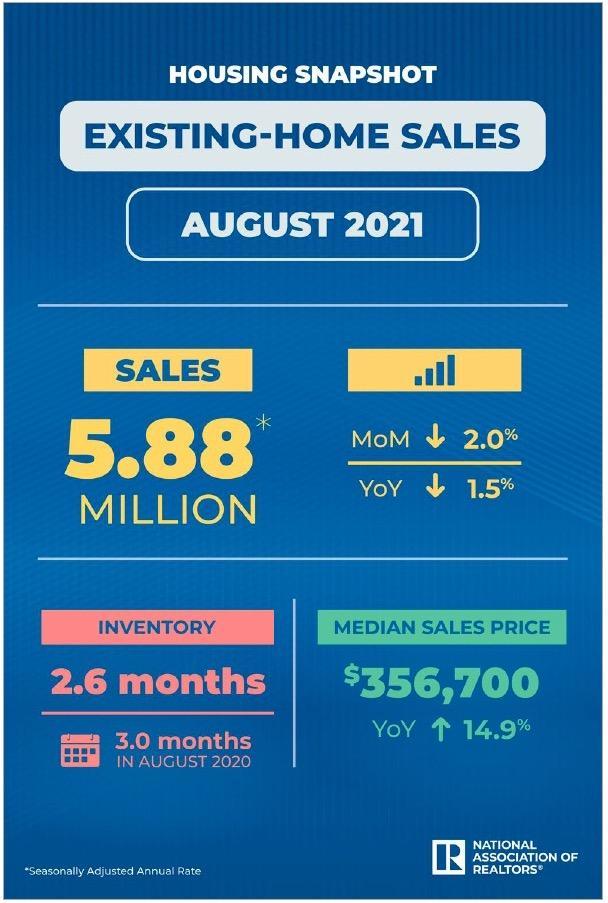Existing-home sales backed up in August, after two consecutive months of increases, according to the National Association of REALTORS® (NAR). Each of the four major U.S. regions experienced declines on both a MoM and YoY basis.
Total existing-home sales decreased by 2.0% from July to a seasonally adjusted annual rate of 5.88 million in August. Year-over-year, sales dropped 1.5% from last year (5.97 million in August 2020).
Single-family home sales decreased to a seasonally adjusted annual rate of 5.19 million in August, down 1.9% from 5.29 million in July and down 2.8% from last year.
Existing condo and co-op sales recorded at a seasonally adjusted annual rate of 690,000 units in August, down 2.8% from 710,000 in July but up 9.5% from last year.

By Region:
Midwest
Existing-Home Sales: 1.37 million (-2.1% YoY) Median Price: $272,200 (+10.5% YoY)
Northeast
Existing-Home Sales: 730,000 (-2.7% YoY) Median Price: $407,800 (+16.8% YoY)
South
Existing-Home Sales: 2.55 million (-0.8% YoY) Median Price: $303,200 (+12.8% YoY)
West
Existing-Home Sales: 1.23 million (-1.6% YoY) Median Price: $507,900 (+11.4% YoY)
What the industry is saying:
“Sales slipped a bit in August as prices rose nationwide. Although there was a decline in home purchases, potential buyers are out and about searching, but much more measured about their financial limits, and simply waiting for more inventory. High home prices make for an unbalanced market, but prices would normalize with more supply. Securing a home is still a major challenge for many prospective buyers. A number of potential buyers have merely paused their search, but their desire and need for a home remain.” — Lawrence Yun, Chief Economist, NAR
“We will continue working with federal policymakers and stakeholders from across the industry in an effort to increase housing supply and ensure the American Dream of homeownership remains accessible to as many people as possible.” — Charlie Oppler, President, NAR
“While housing activity has clearly cooled from its frenzy during the midst of the pandemic, home sales remain well-above the pre-pandemic pace and the median sales price continues to grow, albeit at a slower pace. A still-large number of young households are driving housing market activity, and leveraging the boost in purchasing power provided by low mortgage rates. Despite this, rising home prices mean that today’s buyers are spending larger shares of their paychecks to buy the typical home, and that trend could eventually cause some buyers to put home searches on hold, especially if mortgage rates begin to rise in response to expected tapering of asset purchases by the Fed later this year.
“Those who continue their home searches in the cooler months ahead are likely to be pleasantly surprised. Not only do we expect to see the usual seasonal respite from the competitiveness of the spring and summer home-buying season—making early fall the best time to buy a home—the return of sellers to the housing market driven by the improving economy and diminishing health risks could accentuate this trend.
“Additionally, recent construction figures show that builders continued to ramp up production in August and their outlook remained high in September, even as supply-chain challenges continue. These modest improvements are welcome, but haven’t changed the big-picture state: there are not enough homes for sale. Despite the recent improvement, single-family construction would still need to double to close the gap with household formation that accumulated over the last decade within the next five to six years.” — Danielle Hale, Chief Economist, realtor.com®
“Moving into the fall we continue to expect to see year-over-year declines in home sales related primarily to a return to normal seasonal patterns. This is a result of the base-effect created by the abnormal surge in home sales we saw in late Q3 and Q4 of 2020. The economy has continued to strengthen despite the recent surge in the Delta variant and we see the fundamentals behind housing demand remain strong looking at the rest of 2021 and into 2022.
“Home prices remain our primary source of concern as affordability becomes an increasing challenge, particularly for first time homebuyers who have not had the opportunity to benefit from the wealth created from recent surges in home equity. We expect that the Federal Reserve will likely give further indication on timing this week on reductions in Mortgage Backed Securities purchases.
“In multiple meetings, the Fed has pointed to trends in home prices as potential justification for reducing asset purchases, implying the upward pressure on mortgage rates would be useful in helping slow the pace of home price appreciation. Overall we think home sales will remain strong going into next year, but we should see inventory levels continue to slowly trend toward more normal levels and home price appreciation begin to slow over time.” — Ruben Gonzalez, Chief Economist, Keller Williams
For more information, please visit www.nar.realtor.
